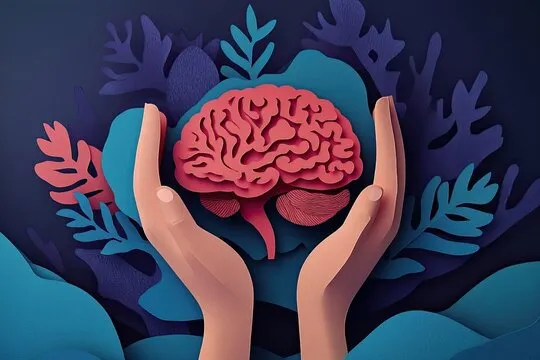(PPT attached at the end of the post)

Hello, folks. Today, let’s examine our ideas, emotions, feelings, and awareness. More than 2,500 years ago, a prince-turned-seeker, sitting beneath a Bodhi tree, conceived the concept we will examine. His primary goal was to understand himself. He resolved not to rise until he grasped the mind. He was Siddhartha Gautama, also known as the Buddha. He discovered what is now known as mindfulness: the art of observing thoughts without judgment.
“The intellect encompasses everything. “What you think, you become.” – The Buddha The aforementioned phrase is one of Buddha’s best quotations. In a broader sense, we are simply the result of our thinking. Today, modern neuroscience is catching up to ancient wisdom. Modern science has debated Buddha’s intuition, and research now shows that mindfulness alters the brain.
Have you ever found yourself scrolling continuously, zoning off while eating, growing irritable, and reacting with frustration without even realizing it? Such conduct implies that your brain is operating on autopilot mode. But here’s the good news: you can regain control. Mindfulness is a neuroscience-backed technique that can positively impact the brain. And it is surprisingly simple.
Let’s explore how being present not only rewires your brain but also feels good.
What is mindfulness, really?
Mindfulness is the practice of paying attention purposefully in the present moment without any judgment. That is, ‘Be present here.’ It’s not about “emptying your mind. It is about becoming aware of what’s happening inside and around you. Research shows that even a few minutes of daily mindfulness can lead to lasting changes in the brain.

Brain on Mindfulness
Mindfulness practice reshapes our brain physically by making changes in the neuron network. Please allow me to explain it step by step.
1. Thicker Prefrontal Cortex (Better Focus)
The prefrontal cortex (PFC), the part of the brain behind our forehead, is the executive control center of the brain. It helps you stay focused, plan, manage your impulses, and make conscious decisions. Studies using MRI scans showed that people who regularly practice mindfulness have increased thickness and activity in the PFC area. This implies that they are better at resisting distractions, maintaining their composure in emotionally challenging situations, and responding instead of reacting. A powerful PFC is an indication of improved mental clarity, productivity, and emotional regulation.
2. Enhanced Anterior Cingulate Cortex (Stronger Self-Control & Awareness)
Another region where mindfulness can enhance is the anterior cingulate cortex (ACC). The ACC helps you stay focused on your goals, monitor conflicting thoughts, and shift your attention smoothly when needed.
The mindfulness research indicates that ACC has reduced impulsivity and improved error detection in individuals who practice mindfulness. It helps you to pause before reacting, recognize unproductive thought loops, and thereby redirect attention. Practicing mindfulness strengthens this “attention manager” so you’re more free from autopilot mode and aware of what you’re doing.
3. Shrinks the Amygdala (Less Stress)
The amygdala is your emotional radar. It triggers fight-or-flight responses. Long-term mindfulness practice reduces its size and activity, which in turn makes us remain calmer even under pressure.
4. Boosts the Hippocampus (Better Memory)
This brain region is linked to learning and memory. Mindfulness has been shown to increase the density of grey matter in the hippocampus, supporting a better memory.
5. Improves Default Mode Network (Fewer Mental Loops)
The Default Mode Network (DMN) is active when your mind wanders or overthinks. Mindfulness quiets the DMN, helping you to keep away from unnecessary negative thoughts and daydreaming.

Real Benefits You’ll Feel
Due to the changes in our brain, you will feel
Reduce anxiety and emotional reactivity.
Improve sleep and attention spans.
Increase empathy and compassion.
Help break harmful habits by increasing self-awareness.
You no longer need to meditate in a cave for years to get these benefits. Dedicate five or ten minutes daily to make dramatic changes in your brain, which in turn will make you a better version of yourself in just eight weeks. Mindfulness isn’t reserved for monks—it’s built for real people to cope with their daily stress and frustration.
.
How to practice?
There are NO strict principles or rituals in mindfulness practice. Sit comfortably in a chair. If it is not possible, lie down, but don’t fall asleep! Take one deep breath. Then breathe normally. Your role is to observe the incoming and outgoing breath. Thoughts may come; don’t try to suppress them, but just observe them like a witness and return to the counting process. That’s all. Start with five minutes; gradually increase the time.
The “STOP” Technique
It is one of the most effective ways to practice mindfulness in everyday life. Here’s how it works:
S = Stop whatever you’re doing. Just pause for a moment.
T = Take a breath. Inhale slowly; exhale fully. Feel the flow of breath.
O = Observe. Notice what’s going on inside you: your thoughts, emotions, and sensations. Also observe the surroundings—the different types of sounds, etc.
P = Proceed. Move forward mindfully, with intention rather than impulse.
Let me take a specific example to demonstrate the STOP technique.
Example: Let’s say you’re preparing for a presentation. You might be experiencing some anxiety.
1. Stop and take a short pause.
2. Take a breath or two, slowly and deeply.
Feel the tightness in your chest; acknowledge the fear without judgment.
3. Observe: Pay attention to your feelings, including your breath rate, pulse, and body sensations.
4. Proceed by telling yourself, without any judgment, “I’m nervous; still, I’ve prepared well. I will approach this one step at a time.
By doing this technique, you have interrupted a stress loop using mindfulness. With practice, this becomes your nature. You can also use apps like Headspace, Insight Timer, or free YouTube meditations to build consistency.
Final Thought: Mindfulness Is Mental Strength
“Peace comes from within. Do not seek it without.” – Buddha
We are searching for peace outside like the musk deer searching for the smell of musk.
Your brain is malleable, not inflexible. This implies that you can reshape your brain. Mindfulness is like a gym for your mind: the more you practice, the stronger your focus, calm, and clarity become.
Just start with one breath (all of us started with that one breath, but we forgot!). One pause. That’s where the roots of transformation germinate!
For time-bound learners, a PPT of the topic may be downloaded from here.